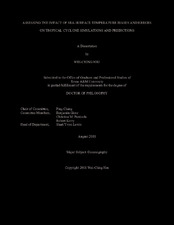| dc.description.abstract | Tropical cyclones (TCs) are one of the most impactful natural hazards to people’s life and
economy, and improving forecast and future projection of TCs is one of the most important areas
for the weather and climate research community. Previous studies show that sea surface
temperature (SST) patterns both local to and remote from TC development regions are important
drivers of the variability of TC activity on different timescales. Thus, reliable simulations and
predictions of TC activity depend on a realistic representation of tropical SSTs. Nevertheless,
severe SST biases are common to the current generation of global climate models, especially in
the tropical Pacific and Atlantic, where TCs are active. Alleviating these SST biases has proven
challenging, leading to the prospect that the bias problem may persist for decades, even with
improvements in our understanding of the causes of the biases and in reducing the biases in the
newer version of climate models. It is, therefore, crucial to understand and evaluate the effects
of the biases on simulations of climate extremes. Using an atmospheric-only tropical-channel
model (TCM), we investigated the impact of SST biases and uncertainties in SST prediction on
TC simulations. The simulation results show significant influences from SST biases on TC
simulations both in local basins and remote ocean basins. Moreover, ensemble dynamical
downscaling experiments using TCM forced by SST anomalies derived from CESM Decadal
Prediction Large Ensemble (CESM-DP-LE) experiments also reveal impacts from uncertainties
in lateral boundary conditions, suggesting that uncertainties in tropical SST prediction may not
be the only dominant factor limiting TC predictability. Last but not least, we explored the
prospect of multiyear-to-decadal TC prediction by evaluating the skill of CESM-DP-LE in
predicting TC-related environmental condition changes on multiyear-to-decadal time scales. The
results show that CESM-DP-LE is highly skillful in predicting TC genesis potential index (GPI)
on multiyear to decadal timescales. In particular, it successfully predicted the decadal shift in the
mid 1990s when the Atlantic TC activities increased abruptly. This result paves the way for
further study of decadal TC forecast. | en |


